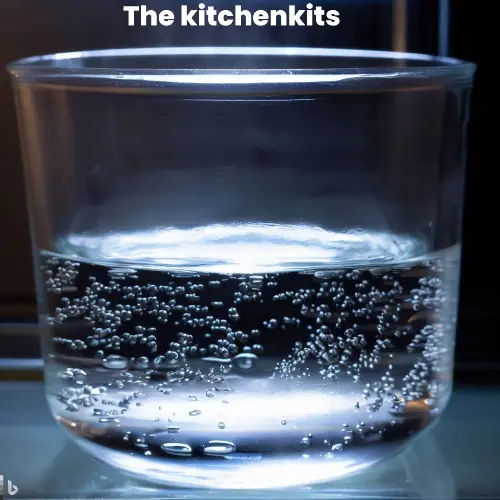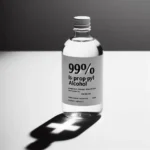Table of Contents
How To Make Distilled Water In The Microwave
Are you looking for an easy way to make distilled water right home? Making your own distilled water is quite simple if you have a microwave.
In this article, we’ll explain how to filter water in a microwave, discuss the benefits of distilled water, and provide tips for safely making purified distilled water at home. After reading, you’ll know how to easily make distilled water using items you likely already have in your kitchen!
Why Make Your Own Distilled Water?
Before jumping into the how-to, you may be wondering why you’d want to make distilled water at home in the first place. There are several great reasons to make your own distilled water rather than buying it:
- It’s more economical. Store-bought distilled water can get expensive over time. Making it yourself eliminates this ongoing cost.
- You can make small batches. Distilling your water allows you to make as much or as little as you need. No more wasting money on larger bottles or running out before you can get to the store.
- It’s convenient. With the microwave method, you can make distilled water any time you need it with minimal effort. Much more convenient than buying and lugging home bottles from the store!
- You control the purity. By distilling your own, you can ensure it’s been freshly purified precisely how and when you need it.
- It’s useful for appliances. Appliances like steam irons, humidifiers, and CPAP machines require distilled water. Having an easy DIY method means you always have some on hand.
- Now that you know why making your own is advantageous, let’s understand how simple and quick the process can be.
How Does Distillation Work?
To understand how to distill water, it helps first to understand what distillation is. Distillation is a purification process that relies on the different boiling points of water and impurities. Here is a quick explanation of the simple process:
- Water is heated to its boiling point, turning it into vapour/steam that rises up and away from the contaminants left behind.
- As the purified vapour moves across the air, it cools and condenses into liquid water.
- The condensed purified water is then collected in a clean container, leaving behind minerals, chemicals, and impurities from the original water source.
This heating, evaporating, condensing, and collecting is the basic distillation process used to purify and sanitize water. Pretty neat? Now, let’s look at replicating this with a microwave and a few supplies.
Supplies Needed to Distill Water in a Microwave
The good news is you likely already have everything you need to start distilling water. For this simple process, you’ll need:
- A microwave-safe bowl or glass container
- A smaller microwave-safe bowl or glass container
- Tap water
- Microwave
That’s it! Just two containers and water. Please ensure the container you’ll collect the distilled water in is smaller to fit inside the larger container, as you’ll see in the steps. Glass Pyrex containers work great for this.
Step-by-Step Instructions
Now we’re ready to go through the easy steps for how to distil water in the microwave:
- Fill the sizeable microwave-safe container about halfway with regular tap water. This container will be used to heat and evaporate the water. Don’t fill as you don’t want it boiling over when heated.
- Place the smaller collection container inside the larger container. Make sure the smaller container sits securely in place and is fully immersed in the water.
- Place the large container holding both bowls of water in the microwave.
- Heat the water. Heat the water at full power until it begins boiling. This typically takes 3-5 minutes, depending on your microwave wattage.
- Allow to boil for 1-2 minutes. Heating the water to a rapid boil helps ensure impurities and contaminants are fully evaporated.
- Turn off the microwave and allow the water to cool for a minute or two. Once turned off, the steam will condense along the sides and top of the giant bowl and drip down into the collection bowl.
- Carefully remove the smaller collection bowl containing the distilled water. Be cautious, as the water will be hot.
- Allow the distilled water to cool before use or storage fully. It’s best to let it cool to room temperature before drinking or adding to appliances.
And that’s it – you’ve just used your microwave to distil water at home quickly! As you can see, it’s a rapid and straightforward process using everyday kitchen items.
Tips for the Best Results
To get the highest quality and quantity of distilled water, keep these tips in mind:
- Bring the water to a rapid boil for best evaporation.
- Allow all the steam to fully condense and collect before removing.
- Use glass or stainless steel collection containers for the best purity.
- Start with the purest water possible – filtered water is even better than a straight tap.
- Distill in small batches so the steam can condense more efficiently.
- Let the freshly distilled water cool thoroughly before use or storage.
Follow these tips, and with some practice, you’ll be an expert at making clean distilled water at home with your microwave.
Safety Considerations
As with any method of boiling water, there are certain safety precautions to keep in mind:
- Use caution when handling hot containers.
- Take care not to spill any hot water when removing containers.
- Keep your face and body away from the top when removing lids or bowls.
- Make sure to vent lids or bowls so steam can escape rather than cause an eruption.
- Allow all water to fully cool before handling the collection bowl.
- Take extra care and use lower power if heating water in glass containers.
You can safely make your own distilled water by taking appropriate care when handling hot water and containers.
Why Distilled Water in Microwaves Works
If you’re wondering why this simple microwave method works so well, it depends on how quickly microwaves heat water. Microwaves heat liquids incredibly efficiently by causing water molecules to vibrate rapidly.
This agitation makes water quickly reach its boiling point, at which it evaporates into steam, leaving behind impurities unable to vaporize at such heat. This quick boiling, followed by moisture condensing into purified water, makes the microwave an easy and practical DIY distiller!
Storing Your Distilled Water
Once sufficiently cooled, here are some tips for storing your freshly distilled water:
- Store in clean, airtight glass or stainless steel containers.
- Glass Mason jars work great for storing smaller batches.
- Larger batches can be kept in jugs or bottles designed for water.
- Consume within 1-2 weeks for best quality and taste.
- Keep containers in the refrigerator if not using right away.
Proper storage helps preserve your homemade distilled water’s purity and fresh taste.
Uses for Distilled Water
Now that you know how to make it fresh anytime, here are some of the top uses for your homemade distilled water:
- Drinking water – Use your regular water for drinking and cooking.
- Coffee machines and humidifiers – help prevent mineral buildup.
- Irons and steamers – recommended for best performance.
- CPAP machines – distilled water prevents bacteria and mineral deposits.
- Auto radiators and batteries – help reduce corrosion.
- Aquariums and ponds – less chemicals than tap water.
- Sensitive skin – great for skin care, masks, and treatments.
As you can see, there are so many uses! Any application for purified or distilled water is perfect for your homemade supply.
FAQS
What is distilled water?
Distilled water is a type of water that has been purified through distillation. Distillation involves boiling the water and then collecting the steam, which is cooled and condensed into liquid form. This process removes impurities and contaminants, leaving water free from minerals, chemicals, and other unwanted substances.
Is it safe to drink distilled water?
Yes, it is generally safe to drink distilled water. The distillation removes impurities and contaminants, making the water pure and free from harmful substances.
However, it is essential to note that distilled water does not contain minerals naturally found in other types of water. Some people prefer to consume water that still contains minerals for their health benefits.
Can I make distilled water at home?
Yes, you can make distilled water at home using various methods, including a water distiller, a stovetop pot, or a microwave. The process involves heating the water until it turns into steam and then collecting the condensed moisture as distilled water. It is a simple and effective way to obtain distilled water for various purposes.
What are the different types of water?
There are several types of water, including tap water, bottled water, mineral water, spring water, purified water, and distilled water. Each type has its characteristics and may undergo different treatment processes to remove impurities and contaminants.
Why should I use distilled water?
Distilled water is commonly used for specific applications requiring pure and uncontaminated water, such as in scientific experiments, medical procedures, and household appliances. It is also often recommended for use in steam irons, humidifiers, and car batteries to prevent mineral buildup and prolong their lifespan.
Can I use tap water instead of distilled water?
While tap water can be used in some applications, it may contain minerals, chemicals, and other impurities that can affect the performance and lifespan of specific devices or appliances. In situations where purity is essential, such as in medical equipment or laboratory experiments, it is best to use distilled water to ensure accurate results and prevent potential damage.
How is distilled water made in a microwave?
To make distilled water in a microwave, you need a microwave-safe bowl, tap water, a microwave-safe cup, and a microwave-safe lid or plastic wrap. Fill the bowl with tap water, place the upside-down cup in the centre, and cover the bowl. Microwave the bowl on high for approximately five minutes or until the water starts boiling. The steam rises and condenses on the upside-down cup, creating distilled water.
Is distilled water the same as pure water?
Distilled water and pure water are similar in that they both undergo processes to remove impurities and contaminants. However, pure water can refer to any water treated to remove impurities, while distilled water specifically refers to water that has gone through the distillation process.
Can I use distilled water in a microwave for cooking?
While distilled water can be used in a microwave for cooking purposes, it is essential to note that it may not add flavour or nutrients. Distilled water is primarily used for its purity and lack of impurities. If you prefer to use water that still contains minerals or want to enhance the flavour of your dish, you may opt for other types of water.
Conclusion
As you’ve learned, using your microwave to make distilled water at home is an easy, fast, and money-saving technique. You can safely have purified distilled water ready for all your needs in just a few minutes.
With a bit of practice, you’ll have mastered how to:
- Efficiently distil small or large batches of water.
- Collect and store the purified water properly.
- Use your freshly distilled water for drinking, appliances, and more.
Hopefully, this article has shown you how straightforward it is to make high-quality distilled water anytime with items you likely already have. Give it a try, and soon, you’ll wonder why you bought distilled water when making it yourself is so fast and easy!

I’m Ian Welkins, a seasoned professional in the kitchen industry. My passion now drives me to provide invaluable insights into the world of top-notch kitchen products. With years of hands-on experience, I’m your go-to source for culinary excellence.











